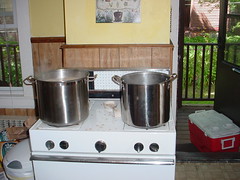So, I just made my first all-grain brew a few days ago. Needless to say, I wasn’t really sure how to do it, so here is what I did. Maybe it will help you out. I learned most of the information here from the guy at the Modern Homebrew Emporium in Cambridge, and [amazon-product type=text text=”Homebrewing Guide”]0882669052[/amazon-product] by Dave Miller. I am describing the step-mashing process, which is one of a few different popular methods. If you’ve tried one of the other methods, I’d love to hear about it.
This process will add a few hours on to your brew time, and really make it into an all-day activity, but it will give you much more control and satisfaction over the end product. And, anyway, you don’t brew your own beer because it’s easy, right?
 I am assuming that you know how to do a basic extract-based brew, so I will just focus on the mashing process. After that point, it is the same process, except that you will have to boil more liquid. If you have a pot big enough to hold your whole batch, then you are all set. However, you may have to split your batch into two pots, like I did.
I am assuming that you know how to do a basic extract-based brew, so I will just focus on the mashing process. After that point, it is the same process, except that you will have to boil more liquid. If you have a pot big enough to hold your whole batch, then you are all set. However, you may have to split your batch into two pots, like I did.
[ad]
On Hopbacks
A hopback allows you to hop your brew just before cooling it. The advantages here are, of course, the ability to add hop flavor, without adding bitterness. This is a somewhat similar result to dry-hopping.
I decided to build a hopback when I bought a plate chiller. I was dissatisfied with my immersion chiller, which I felt took to long to cool the wort. So, I bought a plate chiller, which is a smaller version of what the big breweries use. Basically, you have cold water running between copper plates counterflow to your wort.
When I was doing some research about plate chillers, I found that it was good to put a hopback in the line before them, after your brew kettle. This will keep the hop solids and hot break from clogging the plate chiller.
I found a couple of websites explaining how to make a hop back, so I read them , got some ideas, and then made my own. Here are my notes on how I made mine.
[ad]
Read More »